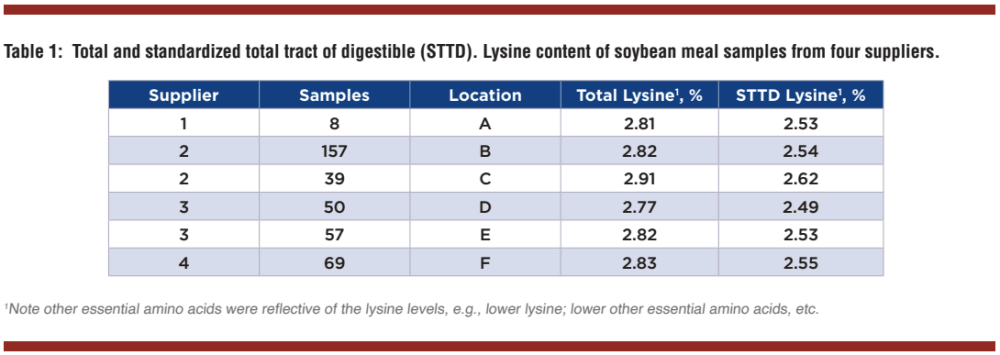Better understanding of nutrient composition and variability of ingredients with routine use of NIR can positively impact swine profitability.
Published Wednesday, 1st February 2023Authors: Gustavo Cordero, Swine Technical Manager; Laura Merriman, Swine Technical Service and Peter Wilcock, Regional Director - North America at AB Vista.
Ingredient analysis is critical to ensure diets provide all expected nutrients, and wet chemistry is the gold standard. However, it’s labor-, time-, and cost-intensive. Near infrared spectroscopy (NIR) can provide an alternative or partial replacement. NIR is a well-established analysis for testing feedstuffs and finished feeds for nutrient composition that provides quick and accurate analyses at a minimal cost to allow for a higher frequency. Increasing the number of samples provides a better understanding of the variations within the ingredient and different suppliers. NIR can be used to measure multiple factors including proximates, amino acids (total, digestible), phytate, reactive lysine, fiber type (soluble, insoluble and total dietary fiber), lignin, and feedstuff characteristics such as corn particle size.
The optimal time to analyze raw materials is when the current crop is harvested. The nutrient composition of crops change each year based on growing conditions, and understanding what the new crop looks like nutritionally helps better formulate diets. Let’s assume producer XYZ has six feed mills in their system and purchases soybean meal from four different suppliers. Producer XYZ uses NIR technology and measures total and digestible lysine at each farm (Table 1) at harvest. Because NIR was used, a high number of samples could be tested.
There was a 5% difference between the highest (2.62) and lowest (2.49) average digestible lysine of SBM by location. In a typical corn- and SBM-based diet for grower pigs (25-50 kg), there is a potential difference of up to 0.04% in the final feed. If not accounted for, this could negatively impact animal performance or, if adjusted for in the formulation to balance lysine amino acids, cost $1.20 per ton. Alternatively, if producer XYZ used more SBM from one of the suppliers with a higher STTD lysine (e.g., Supplier 2 Loc: C) at a similar purchase price as a source with lower STTD, it would provide a feed formulation solution, up to $1.20/t. This demonstrates understanding raw material supply and attributing the right nutrients to meet nutritional strategies.
This can become more critical when looking at an ingredient with a high level of variation, like corn DDGS. Because there are many corn DDGS processing plants, with varied processing techniques, the product varies widely in fat, fiber, and protein content. Fat content in DDGS is dependent upon how much fat is extracted in processing and has impact on metabolizable energy (ME). Research suggests fiber content may also be a factor in predicting ME of DDGS, particularly ADF and TDF (Kerr et al., 2013). Using NIR predictions allows for more corn DDGS samples to be measured at minimal cost and ME determined based on TDF and ether-extracted fat (Kerr et al., 2013). Suppose customer ABC utilized NIR technology to test 60+ corn DDGS samples, submitted from 18 different plants, for proximate nutrients and TDF, allowing ME to be determined. The average TDF was 28% with a minimum of 24% and maximum of 34%. The ME was determined for each source and those were divided into three categories (Table 2).
NIR provides a quick and accurate understanding of the nutrient profile of corn DDGS. This allows nutritionists to categorize DDGS as low, average, or high ME levels, improving the ability to formulate cost effectively to meet nutrient requirements of the pig and may help simplify nutritionists’ daily formulations by limiting the number of corn DDGS specifications they are formulating to.
Corn provides a substantial amount of ME to the diet; therefore, understanding the ME of newly harvested corn is important. NIR uses an equation to measure proximate composition, vitreousness, and protein solubility index. Increasing corn hardness is generally associated with poorer nutritional value for the animal, but a larger impact can be protein solubility.
Corn harvested with a high moisture content is conventionally dried prior to storage, which damages starch and protein, reducing solubility and digestibility. Increasing drying temperature of corn from 54°C to 130°C to target a 13-14% moisture content reduced starch yield from 62% to 43% and increased the level of residual protein concentration in starch from 0.7% to 1.4% (Malumba et al., 2008). This implies protein and starch interactions are a factor when corn is dried at a high temperature, reducing starch and protein solubilities, and negatively impacts ME. This relationship allows two types of corn of similar composition to be differentiated in terms of feeding value based on solubility changes enforced by postharvest treatment. NIR technology evaluates protein and vitreousness alongside the proximate analyses of samples to provide a better understanding of ME in corn.
The capabilities of NIR continue to advance, permitting measurements of amino acids, fiber types, protein solubility, and hardness of corn. This expansion increases potential opportunities for nutritionists to better understand feedstuff quality in diets, optimizing cost-effective production. Coupled with the ability to measure high numbers of samples quickly and accurately, NIR is a great tool for a quality control nutrition program.
Latest news
Stay ahead with the latest news, ideas and events.

Online Feed Fibre Calculator
Calculate the percentage of dietary fibre in your feed
Our calculator is designed for nutritionists and uses averages of global raw materials to calculate the dietary fibre content (plus other more in-depth fibre parameters) of finished animal feed. These parameters are available within AB Vista’s Dietary Fibre analysis service (part of our NIR service).
Sign up for AB Vista news
A regular summary of our key stories sent straight to your inbox.
SUBSCRIBE© AB Vista. All rights reserved 2025
Website T&Cs Privacy & Cookie Policy Terms & Conditions of Sale University IDC policy Speak Up Policy


























